GRID METALS CORP. ( formerly Mustang Minerals Corp. ) is focused on exploration and development of high demand battery metals used in the automotive sector including the growing electric vehicle battery sector and grid storage network. Grid has a diversified portfolio of high potential projects in secure North American mining jurisdictions near quality infrastructure. With the price of palladium rising in recent months the Company is currently focused on exploration at its East Bull Lake Palladium property. Grid recently added Dr. Dave Peck to head up exploration. Dr. Peck is one of the leading PGE- Nickel geoscientist in North America.
The East Bull Lake Palladium Project is located 80 km west of Sudbury Ontario. The Property covers 80% of the ~20km x ~ 4 km layered East Bull Lake Intrusion. The Property hosts different styles of PGM mineralization including “Contact Style” mineralization which occurs along the south margin. No systematic exploration for PGM has occurred since 2002 when the Property was the subject of a joint venture funded by Falconbridge Limited.
EAST BULL LAKE PALLADIUM PROJECT
Overview
The 100%-owned East Bull Lake (EBL) palladium property covers 80% of the highly prospective EBL intrusion. The intrusion is the type example of a series of palladium-rich mafic complexes that occur in the greater Sudbury region. These bodies formed during a major, global-scale episode of mafic and ultramafic magmatic activity that produced significant palladium, copper-nickel sulfide and chromite deposits in Canada, Scandinavia, Russia and Brazil approximately 2.5 billion years ago. The EBL intrusion shares many geological and geophysical characteristics with the older Lac des Iles (LDI) complex in northwestern Ontario – host to Canada’s only primary palladium mine. Importantly, the EBL intrusion was recently confirmed to host the same style of structurally-controlled palladium mineralization that constitutes the majority of past and present palladium resources at LDI, which exceed 200 million tonnes of open pit and underground mineralization with over 10 million ounces of contained palladium. The EBL project is also directly analogous to palladium-rich sulfide deposits that occur in northern Finland including the Arctic Platinum project (APP) with current palladium resources totalling 208.5 Mt averaging 1.47 g/t Pd (9.8 million contained ounces). Despite its palladium pedigree, the EBL intrusion remains chronically under-explored compared to the much smaller LDI complex and to several similar-age intrusions in both Canada and Finland. The Company is now embarking on a new phase of systematic exploration on the property that is focused on the discovery of large, palladium-rich deposits having similar grade-tonnage attributes to the LDI and APP deposits. The new programming is guided by the significant knowledge gained from over 40 years of intermittent exploration at EBL and by recent, critical insights into the controls on the development of large palladium-rich deposits in similar geological environments.
Property Location and Access
The property is easily accessible from the city of Sudbury, located 80 km to the east, by way of an all-weather Provincial road that connects to the Trans-Canada Highway. Sudbury is a world leading nickel, copper and platinum-group metal (PGM) mining and smelting centre with a highly skilled mining work force and a surface and underground mining heritage that spans ~150 years.
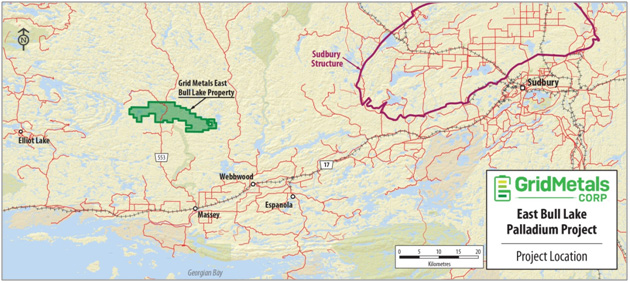
Location of the EBL property in the Sudbury area, northeastern Ontario.
Geology
The East Bull Lake intrusion is over 20 km long and comprises two magmatic centres (east and west lobes) connected by a narrow east-west trending ‘neck.’ The ultimate size of the intrusion is not known but limited deep drilling and 3D geophysical models suggest that the base of the two lobes locally exceed 1 km in depth and may extend much deeper. Critically, the property is cut by a network of criss-crossing northwest-trending and northeast-trending faults, any of which may have acted as feeder structures during emplacement of the EBL intrusion. These faults tend to produce strong, positive magnetic anomalies that reflect their infiltration by mafic dykes formed during the end-stages of magmatism associated with the EBL suite of intrusions. The internal geology of the EBL intrusion is well documented in a series of Ontario Government maps and reports and more recent academic publications. In brief, the intrusion is dominated by mafic rocks including melanocratic to leucocratic gabbronorite, olivine gabbronorite, pyroxenite and anorthosite. The lower part of the stratigraphy of the intrusion is dominated by brecciated anorthosite and leucocratic gabbronorite containing local patches of varitextured gabbronorite. This part of the intrusion represents a dynamic period of magma injection featuring high energy pulses of magma presumably channeled vertically through, and laterally away from, major feeder faults. The lower stratigraphy is the primary host to the many known palladium zones on the property.
Palladium Mineralization
The known distribution of palladium mineralization on the EBL property is illustrated on the map, below. Several palladium zones have been discovered over >30 years of intermittent prospecting and exploration. Most of these zones were initially thought to be related to the margins or basal contact of the intrusion. A recent re-assessment of the property data by Grid indicates a strong structural control on most of the known Pd zones on the property including a spatial association with cross-cutting faults representing potential feeders to the intrusion.
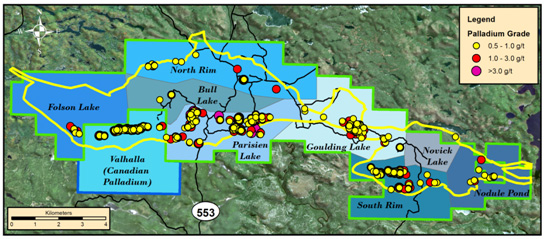
Location of Pd-rich samples (core and surface) on the EBL property.
Exploration History
Miscellaneous Individuals and Companies
1952 – 1992
Drilling by Silcross Copper Mines (3 holes) north of the Parisien Lake Area with best assay of 1.65% Cu and 8.81% Ni (no PGE assays). Drilling of 14 holes by El-Pen Ray Oil and Mines Ltd. (Moon Lake Area) returned best assay of 0.49% Cu and 3.93% Ni (no PGE assays).
1982-1989
Atomic Energy of Canada completed mapping, stripping and ground and airborne geophysics and drilled 4 holes to assess EBLI as potential radioactive waste storage site.
1987-1990
First PGE focused exploration of the EBLI included airborne magnetic and EM surveys and trenching. Best assay returned 13 g/t Pt and 4 g/t Pd in contact-style mineralization from trenches.
1990-1996
Ontario Geological Survey and Laurentian University completed detailed geological metallogenic and petrogenic studies of the EBLI.
1991-1992
Inco Exploration completed mapping and drilled 5 holes (1512m).Best assays were 1.1 g/t combined Pd + Pt, 0.57% Cu and 0.22% Ni and 3.4 g/t Pd + Pt, 14.7% Cu and 0.49% Ni.
1994
Peter Chubb – M.Sc. thesis, Laurentian University. Petrogenesis of the Eastern Portion of the Early Proterozoic East Bull Lake Intrusion.
1995
WMC International Ltd. completed mapping, rock, soil, and till sampling. “Neck Zone” discovered between east and west lobes, comprising semi-continuous zone with up to 5% blebby sulfides with variable Pd enrichment up to several g/t.
1998-2000
Freewest Resources – Folson Lake area. Acquired claims covering prospective Lower Series between Mustang’s Folson Lake and Bullfrog grids. Discovered Valhalla zone during staking. Best assay was 3.1 g/t Pd, 1.3 g/t Pd, 0.2 g/t Au and 0.7% Cu (grab sample). Completed prospecting, blasting, geophysics, and drilled 27 holes (2902m) in Valhalla zone. Most holes intersected highly anomalous PGE values. Best drilling result was 1.96 g/t combined Pd+Pt+Au over 24m.
2000
Aquiline Resources – Parisien Lake area. Completed mapping, IP and magnetic surveys, and drilled 10 holes (1287m). Anomalous PGE values reported from surface sampling and drilling.
Mustang Minerals/Grid Metals and Option-JV Arrangements with Other Companies
1998
Staked claims over newly released areas over the intrusion and acquires existing claims over known mineralized areas from prospecting groups. Completes in-fill staking to form a large, continuous property. Drilled 8 holes in the Moon Lake area with best result of 1.0 g/t Pt+Pd+Rh+Au over 13.5m including 5.6 g/t over 1.5m (hole ME98-01).
1999
Re-logged and re-sampled AECL holes EBL-1, -2, and 4 which returned anomalous PGE values.
Completed mapping, magnetic and IP surveys over newly discovered Bullfrog Zone. Drilled 3 holes with best result of 1.1 g/t Pt+Pd+Rh+Au over 6.5m (hole ME99-11)
1999-2000
Bullfrog Grid area mapping and surface sampling showed Valhalla Zone extends eastward onto Bullfrog grid. Best result was 16 g/t combined PGE+Au but many samples returned combined PGE+Au values exceeding 2 g/t combined PGE+Au. Drilled 11 holes (ME99-12 to ME00-22) and defined a Pd zone with over 600m of strike.
2000
Mapping and prospecting in the north and central parts of the intrusion. Best results include 2.0, 3.8 g/t and 4.9 g/t combined Pt+Pd+Au (grab samples). Limited drilling in central area – no significant results but anomalous Pd detected in some hole.
2001
Falconbridge Ltd. options property from Mustang and completes prospecting, mapping, trenching, and ground and airborne geophysics.
2002
East Lobe drilling (860m ME02-32 to -37). Anomalous PGE values in all 6 holes.
2007
Helicopter VTEM survey completed over most of the claims. Several shallow to deep EM conductors identified.
2008
Parisien Lake area. 6 holes completed. Intersected anomalous PGE in all 6 holes.
Best results was 12.5 g/t Pd+Pd+Au, 9.3% Cu and 0.4% Ni over 1.1m (hole EB08-02).
Western Areas Ltd optioned EBL property from Mustang. Completed ground EM survey over parts of the east lobe. Detects two poorly defined conductor anomalies.
2011-12
Western Areas JV project. Completed ground EM geophysical surveys over Parisien Lake and Bullfrog grids. Drilled 6 holes and extended two existing holes. One hole near the north margin of the intrusion intersected 6.5m of 2.1 g/t Pd+Pt+Au. The best drilling result was from the Parisien Lake area where a 5m interval returned an average grade of 3.2 g/t Pd+Pt+Au, 2.3% Cu and 0.11% Ni.
2017
Bullfrog Zone claims divested by Mustang to Pavey Ark Minerals and combined with Pavey’s Valhalla Zone claims. Later purchased by 21C Metals (now Canadian Palladium Resources Inc.).
2019
Inferred resource announced on Valhalla – Bullfrog zones by 21C Metals. 11.1 million tonnes of 1.46g/t Pd equivalent grade of potential open pit resources.
2020
Grid Metals resumes exploration on the property and completes a ground MT survey over selected structural targets based on the Lac des Iles (LDI) deposit model.
Deposit Model and Targets
Grid is applying the LDI deposit model to guide future exploration programming. This model invokes a primary role for magmatic feeder structures in the trapping of palladium-rich disseminated sulfides into vertically and laterally extensive mineral zones having adequate thickness and grade to support open pit and/or bulk underground mining. Sulfides accumulate in three different setting, namely:
- within the feeder structures themselves
- directly adjacent to the feeder faults within local structural embayments along intrusive contacts with older units
- in dilatant zones developed at the intersection of two or more feeder faults
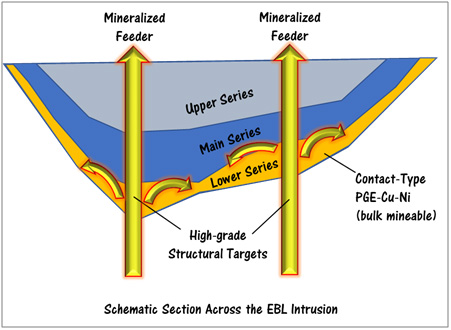
Conceptual deposit model for Pd-rich mineralization in the EBL intrusion.
Analogous deposits to LDI are known from similar age mafic-ultramafic intrusions in Finland. The appeal of LDI-type deposits is their strong palladium enrichment, high palladium tenors (Pd content in the sulfide fraction of the rock) and tremendous thickness compared to the conventional ~1m-thick PGE reef deposits like the JM Reef in Montana and the UG2 and Merensky Reefs in South Africa. The company is focussing its attention on exploring potential feeder faults and associated contact-related sulfide accumulation zones for LDI-type deposits within the upper 1 km of the intrusion. The ultimate goal is the discovery of a major new Pd resource having the necessary tonnage, grade and value to support future economic extraction using open pit and/or underground mining methods.
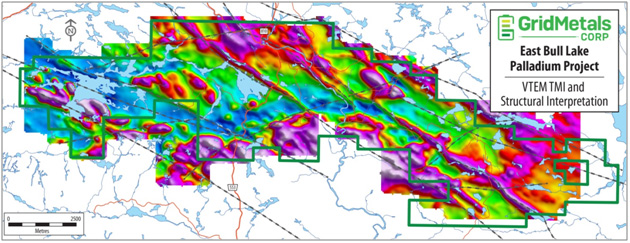
2007 VTEM magnetic survey image over the EBL intrusion showing the location of interpreted, major cross-cutting faults – some or all of which may have acted as feeders to the intrusion.
2020 MT Survey
Initial results from the 2020 MT survey were announced in the Company’s April 28, 2020 news release, which is available for download on this website. The survey was designed to cover two highly prospective target areas including the historical Parisien Lake zone and the southern margin of the east lobe of the intrusion. In both areas, significant Pd-rich disseminated sulfide mineralization is documented from previous surface sampling and drilling programs. In addition, poorly characterized massive Cu-Ni sulfide mineralization with variable Pd grades has been found in surface trenches and intersected in shallow drill holes at Parisien Lake. The MT method has proven successful in the discovery of thick, PGM-rich disseminated sulfide mineralization at the Sunday Lake project in northwestern Ontario (see Impala Canada Ltd. press release dated April 29, 2019). It employs surface measurements of the earth’s electromagnetic field to map out, in three dimensions, changes in rock resistivity that are commonly associated with areas of enhanced sulfide mineral content.
Promising geophysical targets were delineated from the Parisien Lake MT survey and additional targets are developing on the east lobe grid. The source of these anomalies is interpreted to represent either disseminated magmatic sulfide accumulations and/or alteration associated with the mineralization and related feeder structures. Drilling will be required to test these new targets.
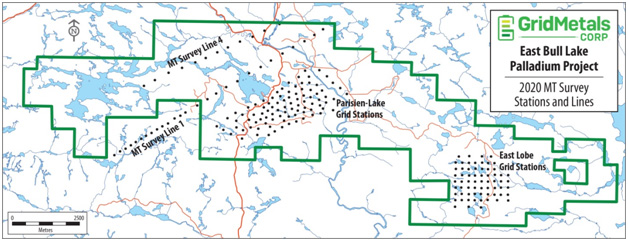
2020 MT survey stations on the EBL property.
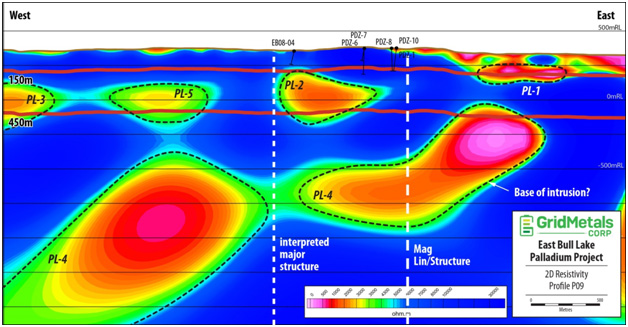
2D longitudinal section across the Parisien Lake target area showing several discrete resistivity anomalies associated with potential feeder structures and directly below known, near-surface Pd mineralization.
The Makwa Mayville Nickel Cobalt PGE Project is located 145 km northeast of Winnipeg Manitoba. A NI 43-101 PEA has been completed on the project which also has significant platinum group metals credits. The project design is a conventional open pit mining operation with an onsite concentrator to produce separate nickel and copper concentrates. The project has significant cobalt and PGE credits.
The Bannockburn Nickel Project is located near Matchewan Ontario south of Timmins. The property was optioned from Outokumpu Mining and is subject only to a 2% NSR. Bannockburn hosts several zones of high grade nickel hosted in massive sulfides including the “C” Zone which outcrops. A mineralized dunite unit with potential for large bulk tonnage has been identified in several drill holes.

